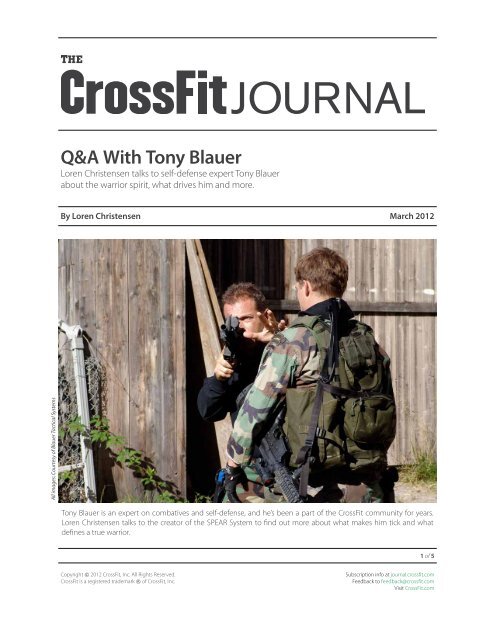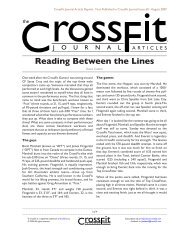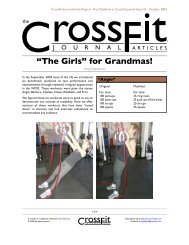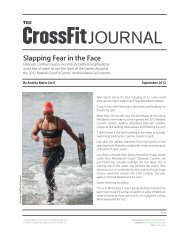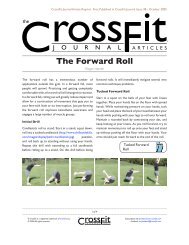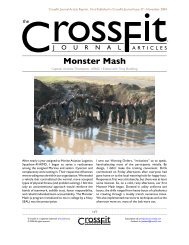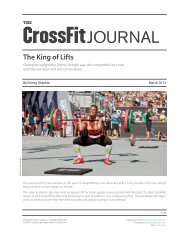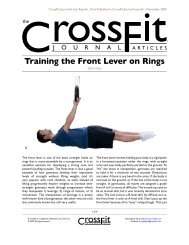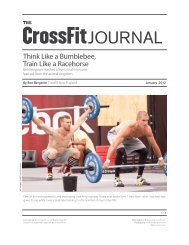Q&A With Tony Blauer - CrossFit
Q&A With Tony Blauer - CrossFit
Q&A With Tony Blauer - CrossFit
You also want an ePaper? Increase the reach of your titles
YUMPU automatically turns print PDFs into web optimized ePapers that Google loves.
All images: Courtesy of <strong>Blauer</strong> Tactical Systems<br />
Q&A <strong>With</strong> <strong>Tony</strong> <strong>Blauer</strong><br />
Loren Christensen talks to self-defense expert <strong>Tony</strong> <strong>Blauer</strong><br />
about the warrior spirit, what drives him and more.<br />
By Loren Christensen March 2012<br />
<strong>Tony</strong> <strong>Blauer</strong> is an expert on combatives and self-defense, and he’s been a part of the <strong>CrossFit</strong> community for years.<br />
Loren Christensen talks to the creator of the SPEAR System to find out more about what makes him tick and what<br />
defines a true warrior.<br />
Copyright © 2012 <strong>CrossFit</strong>, Inc. All Rights Reserved.<br />
<strong>CrossFit</strong> is a registered trademark ® of <strong>CrossFit</strong>, Inc.<br />
1 of 5<br />
Subscription info at journal.crossfit.com<br />
Feedback to feedback@crossfit.com<br />
Visit <strong>CrossFit</strong>.com
<strong>Blauer</strong> ... (continued)<br />
<strong>Blauer</strong> says a warrior is defined by his or her willingness to face adversity and do what’s right.<br />
How do you define a warrior?<br />
That’s such a hard one to answer. Warrior-like action<br />
can manifest itself in so many ways, in so many places:<br />
the courage to face battle, the courage to face fear, the<br />
courage to face reality… . I suppose at the core, a warrior<br />
is defined by his or her willingness to face adversity and do<br />
what’s right. One of my favorite quotes is from Emerson<br />
and pretty much sums it up: “What goes on around you<br />
compares little with what goes on inside you.” In other<br />
words, the true mark of a warrior is often defined by<br />
their personal virtues. That’s the philosophical answer.<br />
Combatively, or more specifically “athletically” speaking, I<br />
see warrior essence demonstrated in contact sports like<br />
boxing, football and so on … . However, many of these<br />
athletes haven’t balanced that skill and responsibility with<br />
some of the more “Renaissance” virtues that once made<br />
the warrior a coveted class.<br />
Why are warriors needed?<br />
Obviously, there are many ways to answer this. Perspective<br />
will influence an answer, and I don’t know if I should focus<br />
on the philosophical or the tactical … the actual combat<br />
realm, but I feel that sheer ability and toughness are only<br />
two components of a totality. At the meta level, I think the<br />
warrior class creates balance in society. And not to get too<br />
esoteric—there’s a DNA aspect to this as well … some of<br />
Copyright © 2012 <strong>CrossFit</strong>, Inc. All Rights Reserved.<br />
<strong>CrossFit</strong> is a registered trademark ® of <strong>CrossFit</strong>, Inc.<br />
us are hunters, others are farmers, artists, doctors and so<br />
on … . I surmise there’s the room to have a little warrior in<br />
every calling. But as this is a warrior interview, let me say this:<br />
there were always warriors, from caveman times to right<br />
now, so for me, it’s not so much “why are they needed” but<br />
rather “when weren’t they needed?”<br />
Who influenced you as a warrior?<br />
So many people have influenced me over so many years<br />
and continue to influence me. I’ve become friends with<br />
many people who are professional warriors and risk their<br />
lives every time they go to work. Even though I’ve met<br />
them through my courses, I’m like Angelo Dundee and<br />
they Ali or Leonard: they’re fighting in the arena and I’m<br />
outside the ropes. These men inspire me to stay razor<br />
sharp and continually innovate new drills to address their<br />
concerns. Having said that, of course it started somewhere.<br />
For me, my first warrior heroes were television warriors.<br />
As a youngster it was Bruce Lee as Kato that transfixed<br />
me. Bob Conrad in The Wild Wild West was super cool.<br />
Sylvester Stallone as Rocky and Sugar Ray Leonard during<br />
the Roberto Duran/Tommy Hearns years. All these men<br />
shaped or formed some idea of what toughness meant<br />
or exhibited something in the way they handled violence<br />
and adversity.<br />
2 of 5<br />
Subscription info at journal.crossfit.com<br />
Feedback to feedback@crossfit.com<br />
Visit <strong>CrossFit</strong>.com
<strong>Blauer</strong> ... (continued)<br />
While I realize three of these guys were TV/movie people,<br />
if you study their stories, you come to realize that what<br />
made them successful were some of the virtues and<br />
elements of conviction, tenacity and will that are requisites<br />
for any warrior. Of course, Conrad was a darn good boxer<br />
as well as martial artist. Bruce Lee, well, he was years ahead<br />
of his time, and Stallone trained very hard and was actually<br />
a decent fighter. Leonard pulled off tactics and strategies<br />
in the ring with unreal competition that most fighters<br />
can only fantasize about. I remember for years in the ’80s<br />
getting up in the early a.m. to go running and coming<br />
home and watching a Sugar Ray fight every day, studying<br />
his ring generalship, footwork, combos and then creating<br />
drills around them for my students. Incredibly, over the<br />
years I met and developed relationships with each man—<br />
save Bruce, who had passed away when I was just 13, but I<br />
ended up being good friends with his son, Brandon—and<br />
was able to share my experience and really connect with<br />
these people who inspired and drove me. Of course, over<br />
the years I’ve studied the Samurai mind, a great deal of<br />
Patton and other leaders who’ve shaped our world.<br />
When I was 13 … I told my<br />
mother that I wouldn’t really<br />
need school because I was<br />
going to develop my own<br />
martial-art system.<br />
Why do you do it week after week, year after year?<br />
I don’t know. It’s what I do. Twenty-four-seven I have<br />
dreams of drills. I’m constantly tearing apart courses<br />
and training principles and searching for a deeper<br />
reality. Sometimes I have no idea where ideas come<br />
from … . When I was 13, my mother asked me what I<br />
was gong to study when I was older, and I told her that<br />
I wouldn’t really need school because I was going to<br />
develop my own martial-art system and be like Bruce<br />
Lee. She smiled, patted me on the shoulder and said, “OK,<br />
sweetie, we’ll talk about this when you’re a bit older.” That<br />
was 30 years ago. I know she’s proud of me, but I don’t<br />
think she quite knows what I do!<br />
Copyright © 2012 <strong>CrossFit</strong>, Inc. All Rights Reserved.<br />
<strong>CrossFit</strong> is a registered trademark ® of <strong>CrossFit</strong>, Inc.<br />
Only another warrior can<br />
really stop a warrior.<br />
Why are warriors a different breed?<br />
A real warrior just is. It’s like the DNA thing I mentioned<br />
earlier. So a real warrior, at the tactical level, finds himself<br />
gravitating toward the training, the analysis and the what<br />
if? Emotionally, warriors are different because they can<br />
focus on the bigger picture … like determining what is<br />
the right thing to do for another person or for their society<br />
(based on their beliefs, of course). This kind of comes back<br />
to my answer for why are warriors needed … . I really think<br />
the warrior class is more a part of a huge human ecosystem<br />
that keeps us all in check, so to speak. I don’t think there<br />
ever was a time when there weren’t warriors, nor do I think<br />
there will be a time when the warrior will be extinct … .<br />
After all, only another warrior can really stop a warrior … .<br />
When the proverbial duel is over, metaphorically speaking,<br />
a warrior still stands.<br />
Why is the “average” warrior willing to risk<br />
everything from embarrassment (I’m thinking of<br />
him screwing up) to injury to loss of life for the<br />
mission (“mission” defined as everything from<br />
chasing down a purse-snatcher to going into an<br />
Afghanistan cave)?<br />
Most likely because of the calling, because warriors are<br />
goal oriented and because a true warrior is somewhat<br />
selfless. So the mission, the objective, the chance to verify<br />
the training is of tantamount importance to the lifestyle.<br />
<strong>Blauer</strong> is constantly thinking of new drills<br />
and training principles.<br />
3 of 5<br />
Subscription info at journal.crossfit.com<br />
Feedback to feedback@crossfit.com<br />
Visit <strong>CrossFit</strong>.com
<strong>Blauer</strong> ... (continued)<br />
How should a warrior’s mindset be each time<br />
he trains?<br />
That really depends on the phase of training he or she’s<br />
at, but training should serve the ultimate objective. One<br />
of my favorite maxims is attributed to the Roman Legions:<br />
“Training should be like a bloodless battle so that battle is<br />
just like bloody training.” Years ago, we coined a concept<br />
called “cerebral calisthenics”; in fact, Martial Art Training<br />
magazine ran a feature on it in the ’90s. The premise is<br />
quite simple, and that is that all training should be threedimensional;<br />
i.e., blend the emotional, psychological and<br />
physical arsenals. Anything you work on should connect<br />
to some sort of scenario so that, irrespective of the drill,<br />
there’s an emotional and psychological rationale for<br />
the exercise. This way, the training triggers and creates<br />
connections between all three arsenals. As well, we remind<br />
warriors that to have theoretical confidence in training, it<br />
must be three-tiered, meaning, there must be physical<br />
conditioning, there must be skill development, and then<br />
lastly there must be strategic and tactical conditioning.<br />
If you don’t blend pain<br />
management and fear<br />
management into the training,<br />
you are not completely<br />
preparing yourself.<br />
What should a warrior’s mindset be as he moves<br />
into danger?<br />
All our training is geared toward performanceenhancement<br />
protocols. I was once asked what the<br />
most important element of a fight was, and I smiled and<br />
said, “The result.” To achieve this we start all our training<br />
attacking fear, since fear is the first opponent. One of our<br />
maxims is, “It’s not the danger that makes us afraid; it’s the<br />
fear of danger.” In other words, to fully engage a threat with<br />
resolute focus, we need to understand what the risk is and<br />
train for the risk. This eliminates fear of the unknown. When<br />
we are in the tactical arena, in other words, the training is<br />
done and this is the fight. We strive to be totally focused on<br />
the task and the opponent.<br />
Copyright © 2012 <strong>CrossFit</strong>, Inc. All Rights Reserved.<br />
<strong>CrossFit</strong> is a registered trademark ® of <strong>CrossFit</strong>, Inc.<br />
<strong>Blauer</strong> integrates research about how fear affects<br />
performance into his training.<br />
A huge part of our training encompasses over two<br />
decades of research into fear and how it affects<br />
performance, and we integrate these behavioral realities<br />
into our training always. Every single one of our drills<br />
blends emotional and psychological components so<br />
that “danger” is just another aspect of the training. In fact,<br />
even with our High Gear scenario equipment, we built<br />
it so that the dispersion properties of the gear allow for<br />
the transfer of energy on impact. This causes pain. Pain<br />
causes fear … if you don’t blend pain management and<br />
fear management into the training, you are not completely<br />
preparing yourself. We have another drill called “Emotional<br />
Climate Training,” and this six-stage drill allows anyone to<br />
apply a researched formula to identify startle/flinch points,<br />
apply pain management and other conditioning aspects<br />
to almost any attack imaginable. What this does is help the<br />
warrior stay in the proverbial Zen moment and just focus<br />
on the threat. Again, my answers are never simple, as real<br />
danger evokes and inspires emotional and psychological<br />
reactions, so those systems that focus mostly on the<br />
physical don’t really prepare for the totality of an assault.<br />
What should a warrior’s mindset be regarding<br />
the risk of getting hurt?<br />
At the training level, we have a maxim: “Training must hurt<br />
at times but should never injure.” Hurt heals; injuries are<br />
permanent at some level. Naturally, this mindset will carry<br />
itself over to real-world activities. At the same time, the<br />
realistic training attitude and effort creates a form of stress<br />
inoculation for the real world, provided the drills replicated<br />
the reality.<br />
4 of 5<br />
Subscription info at journal.crossfit.com<br />
Feedback to feedback@crossfit.com<br />
Visit <strong>CrossFit</strong>.com
<strong>Blauer</strong> ... (continued)<br />
<strong>Blauer</strong> works with <strong>CrossFit</strong> athlete Jeremy Kinnick to demonstrate his warrior-athlete techniques.<br />
What should a warrior’s mindset be regarding<br />
the risk of getting killed?<br />
This is just an extension of the mindset moving into<br />
danger and risk of getting hurt. Again, I come back to<br />
the psychology of fear and the need to manage it during<br />
intense stress and danger. Dan Millman once said, “If you<br />
face just one opponent and you doubt yourself, you’re<br />
outnumbered.” I love that because it sums up the simplicity<br />
of it all. In the heat of the moment, the warrior athlete must<br />
focus on the dynamic of the game, and any and every<br />
distraction potentially can derail the effort.<br />
What should a warrior’s mindset be regarding<br />
having to kill?<br />
The scenario should always dictate the choices one makes<br />
in a confrontation. If the situation is credible, if the requisite<br />
level of force required to achieve “safety” requires it, then<br />
it should be approached simply as another tactic. I’m not<br />
trying to sound cavalier about it. Over the course of 20-plus<br />
years of teaching, I have seen graphically the results of<br />
choosing to fight back too late or not taking the threat<br />
seriously enough. Having had the honor and pleasure of<br />
Copyright © 2012 <strong>CrossFit</strong>, Inc. All Rights Reserved.<br />
<strong>CrossFit</strong> is a registered trademark ® of <strong>CrossFit</strong>, Inc.<br />
working with sport warriors like MMA fighters and boxers,<br />
as well working extensively with real-world warriors<br />
like soldiers and cops, I’ve seen my intuitions about the<br />
importance of mental preparation in conjunction with<br />
realistic training proven correct. In the real world, force<br />
must parallel danger.<br />
This interview was originally published in the book Warriors,<br />
available at LWCBooks.com.<br />
F<br />
About the Author<br />
Loren Christensen is Vietnam veteran, retired police officer<br />
and martial artist. He has written over 45 books and a host of<br />
magazine articles widely enjoyed by the “warrior community.”<br />
Website: LorenChristensen.com.<br />
5 of 5<br />
Subscription info at journal.crossfit.com<br />
Feedback to feedback@crossfit.com<br />
Visit <strong>CrossFit</strong>.com


